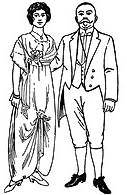Advice for Beachgoers
In the last half of the 19th century, large numbers of Americans discovered the seaside as a place for renewing their health, engaging in physical sports, and socializing. Did authorities really offer the following advice to beachgoers in the late 19th century? Answer "Yes" or "No."

1. Don’t go into the water for at least 2 hours after eating (3 hours is better), and don't go into the water within 1 hour before eating.
Yes. Rarely, an authority would allow that some vigorous individuals might safely venture into the water only 1 hour after eating. The idea for this precaution was that any bathing in cold water—even in an ordinary bathtub, but even more so, swimming in the ocean—diverted normal blood flow in the body, and the belief that this would hinder the digestion of food, resulting in the accumulation of toxins in the body, especially the digestive tract. 19th-century authorities, however, did not mention the dreaded but mysterious "stomach cramps" with which 20th-century authorities, continuing the stricture but losing the original rationale for it, would threaten impatient ocean bathers (but no longer tub bathers). The early rationale for this rule was to prevent digestive malfunction, not muscle malfunction. Until the second half of the 19th century, swimming, that is, "bathing," at the beach was primarily regarded as a form of "marine medication," a therapeutic "watery regimen," not as a pleasant form of recreation or a social pastime.
2. Ocean bathing should provide a shock to your body, so you should stay in the water until you feel a chill or begin to shiver.
No. All authorities warned against allowing oneself to get any kind of a chill in the water. They recognized that some headstrong people liked to dash into the cold water first thing in the morning for a brief dip, but the authorities thought that only the very strongest constitutions could endure this. They recommended instead a number of practices to keep the body uniformly warm during and after one's dip in the ocean—exercising vigorously just beforehand and immediately afterwards, avoiding entering the water when one's perspiration is cooling down the body, energetically rubbing the body with a coarse towel, covering up with a full-length cape or robe, or dressing again immediately in one's regular clothes, getting close to a fire, walking in the sunshine for half an hour, protecting the body from cold drafts and breezes, taking a glass of port wine, using a warm foot bath, avoiding lying down or taking a nap, and avoiding sitting or standing on the beach in one's swimsuit after having been in the water. One should leave the water immediately, it was said, if one felt the "slightest" feeling of chilliness.
3. Enter the water by immediately immersing your entire body, including your head.
 Yes. The recommended practice was to dive into the water headfirst, despite the already-mentioned advice to avoid shocking or chilling the body. The objective was to insure that one's body temperature remain uniform, which it would not if the head were not immersed at the same moment as the rest of the body. This was done in order to prevent "the rushing of the blood to the head," the consequences of which ranged from "unpleasant sensations" to death. Persons who could not swim (and therefore would not be diving headfirst into the sea) were advised to at least wet their heads and chests before immersing their bodies, or to "crouch down and let themselves be covered by the first wave, as they would by an energetic douche," as one authority put it.
Yes. The recommended practice was to dive into the water headfirst, despite the already-mentioned advice to avoid shocking or chilling the body. The objective was to insure that one's body temperature remain uniform, which it would not if the head were not immersed at the same moment as the rest of the body. This was done in order to prevent "the rushing of the blood to the head," the consequences of which ranged from "unpleasant sensations" to death. Persons who could not swim (and therefore would not be diving headfirst into the sea) were advised to at least wet their heads and chests before immersing their bodies, or to "crouch down and let themselves be covered by the first wave, as they would by an energetic douche," as one authority put it.
4. If you are comfortable in the water, you should stay in at least an hour in order to maximize your skin's beneficial contact with the seawater. Another way to accomplish this is to go into the water for a shorter time, but several times each day.
No. Almost every authority on "sea bathing" advised that one should never remain longer in the water than 15 minutes. And that was for the hardiest of bathers, or, as one writer put it, "the strongest aqueously inclined urchin." Typical was this advice: "The length of the first bath should not be more than five minutes at the most. After the third bath one minute can be added to each succeeding one but a quarter of an hour should be considered a maximum beyond which no one should go." Bathers were also warned against entering the water more than once a day.
5. Don't go into the water if you are fatigued or if your "system" is disturbed.
 Yes. However, the authorities didn't advise this simply because of the danger of drowning if one were tired or exhausted. Rather, they advised it also because they believed it to be harmful if one "disturbed" the bodily functions, like respiration, circulation, and digestion, by throwing them out of their usual courses: "Persons coming to the seaside," wrote one such authority, "should wait about thirty-six hours before taking any baths, in order to undergo a process of acculturation as it were so as not to upset their conditions of circulation by their change of residence and by the baths at the same time." How all this was supposed to work was only vaguely articulated, but that did not dampen the enthusiasm of some authorities for invoking the rule: "As bathing is not without its dangers," wrote one of them, "we would warn all boys not to begin the practice too early in the season, or to repeat it too often daily. Many have found an early grave by overindulgence, while others have endured long years of suffering from the obscure effects of excessive bathing."
Yes. However, the authorities didn't advise this simply because of the danger of drowning if one were tired or exhausted. Rather, they advised it also because they believed it to be harmful if one "disturbed" the bodily functions, like respiration, circulation, and digestion, by throwing them out of their usual courses: "Persons coming to the seaside," wrote one such authority, "should wait about thirty-six hours before taking any baths, in order to undergo a process of acculturation as it were so as not to upset their conditions of circulation by their change of residence and by the baths at the same time." How all this was supposed to work was only vaguely articulated, but that did not dampen the enthusiasm of some authorities for invoking the rule: "As bathing is not without its dangers," wrote one of them, "we would warn all boys not to begin the practice too early in the season, or to repeat it too often daily. Many have found an early grave by overindulgence, while others have endured long years of suffering from the obscure effects of excessive bathing."
6.Ladies should wear corsets, or at least corset liners, under their bathing suits in order to conserve their energy and to keep a nice trim figure in the water.
Yes.This practice became widespread at American beaches beginning about 1885, and continued to be common for at least two decades.
7. Sea bathers should not change into their beachwear at their place of residence before coming to the beach, but should arrive at the beach properly dressed in their ordinary clothes and then change into their bathing suits in private beach cottages or tents on the beach.
Yes. Americans, however, were apparently more lax about this rule than were Europeans, who sometimes wrote home scandalized to see people walking to the beach from their hotels already dressed in their bathing suits. Europeans pioneered the use of "bathing machines," beginning in 1750, which were essentially changing rooms on horse-drawn carriages that could be entered fully dressed, drawn down the beach and backed over the surf, from which the bather could emerge and bob up and down in the water before climbing back into the enclosed dressing room and being drawn back up the beach.
8. Neither ladies nor gentlemen should loll about on the beach, chatting, and clothed in their bathing costumes, parading about under the inquiring gaze of the opposite sex, among promiscuous crowds, making a social hour of their visit.
 Yes. This was regarded as undignified and immodest. One was expected to promenade and socialize on or adjacent to the beach (as opposed to being in the water) in one's ordinary clothing, not in one's bathing suit, especially in bathing suits that did not completely cover one's arms and lower legs. Fashion authorities recommended that ladies' bathing suits be made of material, like wool, that would not cling to them. Suits of muslin, for example, would display the intimate details of their bodily forms. Again, Americans were notoriously more lax about these rules than were Europeans. By 1890, newspaper humorists often joked about how scanty—by their standards—ladies' bathing suits had become. By then women's bathing suit fashions were being driven by their desire for uninhibited movement in the water, as well as by their desire to display their bodies to the gaze of admirers.
Yes. This was regarded as undignified and immodest. One was expected to promenade and socialize on or adjacent to the beach (as opposed to being in the water) in one's ordinary clothing, not in one's bathing suit, especially in bathing suits that did not completely cover one's arms and lower legs. Fashion authorities recommended that ladies' bathing suits be made of material, like wool, that would not cling to them. Suits of muslin, for example, would display the intimate details of their bodily forms. Again, Americans were notoriously more lax about these rules than were Europeans. By 1890, newspaper humorists often joked about how scanty—by their standards—ladies' bathing suits had become. By then women's bathing suit fashions were being driven by their desire for uninhibited movement in the water, as well as by their desire to display their bodies to the gaze of admirers.
The Journalistic Community of 1890 Comments on the Modern Bathing Suit:
"The conservative bathing suit is a seaside covering that leaves something for the imagination to do." New Orleans Picayune, June 17, 1890.
"Arabella—'Oh! see, Belinda, here is just the thing I want for my bathing suit.'
Belinda—'Yes, I saw that the other day when I was in this store, but the mean old things won't sell less than a yard.'
Arabella—'Pshaw! Then we will have to try the remnant counter.'"
Boston Investigator, July 2, 1890.
"Brother Tom—'There you are, Mab. Everything is packed, and now for a brilliant opening in the play of seaside engagements.'
Mab—'Yes; but that horrid man hasn't sent me my bathing suit.'
Brother Tom—'I guess it's coming now.'
Mab—'Do you think so?'
Brother Tom—'Yes; there's a messenger boy coming up the avenue with an envelope.'"
Washington Post, July 6, 1890.
"Miss Pretty (in tears and deep distress)—'Oh, mamma! I—went—to—the—trunk-room—and—what—do—you—think—I—fo—fo—fo—found?'
Mrs. Pretty—'I'm sure I don't know, dear. Surely the moths haven't been at your new seal sacque?'
Miss Pretty—'No, not so ba—ba—bad as that—but a moth was shut up with my ba—bathing suit and ate it all up.'"
Chicago Inter Ocean, January 5, 1890.
- "Rules for Bathing," Milwaukee Daily Sentinel, July 15, 1870, p. 1.
- "Rules for Bathing," Independent Statesman (Concord, NH), August 22, 1872, p. 375.
- "Gossip for the Ladies: Bathing and Bathing-Costumes at Home and Abroad," Chicago Daily Tribune, July 25, 1875, p. 14.
- "American Bathing through English Goggles" (reprinted from the New York World), Chicago Daily Tribune, Oct 1, 1876, p. 13.
- "Summer Bathing," Chicago Inter Ocean, August 25, 1877, p. 12.
- "Bathing Costumes," Godey's Lady's Book, August 1887, p. 155.
- "Seaside Manners," New York Times, August 10, 1887, p. 4.
- "The Joys of the Surf," Atlanta Constitution, June 1, 1890, p. 4.
- "What to Wear When Bathing" (reprint from the New York Post), St. Paul Daily News, July 26, 1890, p. 5.
- "Pretty Girls in Sea Robes," St. Paul Daily News, August 25, 1890, p. 3.
- "Open Air Bathing: Practical Rules for Escaping Chills or Other Injurious Effects," (reprinting rules issued by the Royal Humane Society) Atcheson Daily Globe, August 21, 1891, p. 5.
- "Bathing Rules at English Resorts," Chicago Daily Tribune, September 19, 1895, p. 12.
- "As to Mixed Bathing," (reprinted from the New York Herald) Chicago Daily Tribune, August 14, 1896, p. 7.
- "On the Beach," Oakland Tribune, August 1, 1909.
- "General Rules for Bathing," in Mary Ries Melendy, Perfect Womanhood for Maidens—Wives—Mothers (Chicago: Monarch Book Co., 1903), p. 310.
- [Image] Detail of "The Bathing Hour on the Beach at Atlantic City," Harper's Weekly, August 30, 1890, p. 676.
- [Image] "Mixed group bathing, ca. 1880," Frances Benjamin Johnston Collection, Library of Congress. http://hdl.loc.gov/loc.pnp/cph.3b11250
- [Image] "Mrs. Wentworth in bathing suit," photograph dated August 30, 1890. Collection of the New Bedford Whaling Museum. http://www.flickr.com/photos/nbwm/3012058410/
- [Image] "Bathing and Swimming Dresses," Frank Leslie's Illustrated Newspaper, June 28, 1890, p. 458.
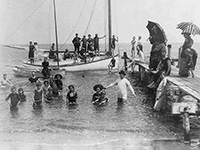





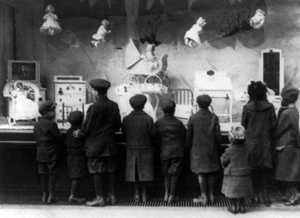
 a pushcart ice cream vendor in New York, in 1896, who also, perhaps, invented the ice cream sandwich by putting a slice of ice cream between waffle squares cut from a sheet. Other sources say the ice cream cone has its origins in the mists of history, but was first described in Mrs. Marshall's Cookery Book, whose author, Agnes Marshall, published it in London in 1888. Still others discern a woman licking an ice cream cone in an 1807 picturing fashionable customers eating at the Frascati café in Paris, although this is uncertain because cone-shaped ice cream bowls were not unknown at the time.
a pushcart ice cream vendor in New York, in 1896, who also, perhaps, invented the ice cream sandwich by putting a slice of ice cream between waffle squares cut from a sheet. Other sources say the ice cream cone has its origins in the mists of history, but was first described in Mrs. Marshall's Cookery Book, whose author, Agnes Marshall, published it in London in 1888. Still others discern a woman licking an ice cream cone in an 1807 picturing fashionable customers eating at the Frascati café in Paris, although this is uncertain because cone-shaped ice cream bowls were not unknown at the time.
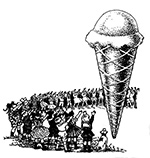

 1. a. Mass Plays, such as the "flying wedge" pictured here (invented in 1892 by a Harvard fan), were tremendously brutal and were soon outlawed. The rules were changed in 1894 so that no more than 2 players could go in motion before the start of the play. Also, the ball carrier's teammates were forbidden to push or pull him.
1. a. Mass Plays, such as the "flying wedge" pictured here (invented in 1892 by a Harvard fan), were tremendously brutal and were soon outlawed. The rules were changed in 1894 so that no more than 2 players could go in motion before the start of the play. Also, the ball carrier's teammates were forbidden to push or pull him.  2. b. For a long time, goals scored more points than touchdowns. Touchdowns were more valuable as a means of getting a favorable placement for an unimpeded try at kicking a field goal. The defense would play in order to prevent a goal rather than defending against a touchdown, making the "dribble" a possible offensive strategy until it was made illegal in 1887. Note that the player holding the ball for the kicker (lying on the ground) in the illustration here had to keep the ball off the ground as the kicker prepared himself because as soon as the ball touched the ground, it was in play.
2. b. For a long time, goals scored more points than touchdowns. Touchdowns were more valuable as a means of getting a favorable placement for an unimpeded try at kicking a field goal. The defense would play in order to prevent a goal rather than defending against a touchdown, making the "dribble" a possible offensive strategy until it was made illegal in 1887. Note that the player holding the ball for the kicker (lying on the ground) in the illustration here had to keep the ball off the ground as the kicker prepared himself because as soon as the ball touched the ground, it was in play.  3. b. This method of putting the ball in play (known as a "fair," as opposed to the play known as a "fair catch," described in the other possible answer), proved too unruly and prone to "slugging" as the players massed together near the sideline. It was eliminated by requiring the referee to bring the ball out from the sideline and place it in the middle of the field.
3. b. This method of putting the ball in play (known as a "fair," as opposed to the play known as a "fair catch," described in the other possible answer), proved too unruly and prone to "slugging" as the players massed together near the sideline. It was eliminated by requiring the referee to bring the ball out from the sideline and place it in the middle of the field. 4. True. When tackling below the waist down to the knees was allowed in 1888, the defense was strengthened and the offense therefore needed to be bolstered by the rules to keep the game balanced. To do this, the teammates of the ball carrier were allowed to "interfere" with (that is, move and block) the opposing team with their bodies (but not their hands and arms—note the illegal use of hands by the blockers in the picture) even after the ball had been snapped. Because these offensive players were in front of the ball after it had been snapped, any movement by them had previously been disallowed as "offsides play." The rule meant that the ball carrier could now run behind his teammates (who would block for him), and not (as in rugby) in front of them, ready to pass the ball back when he was about to be tackled.
4. True. When tackling below the waist down to the knees was allowed in 1888, the defense was strengthened and the offense therefore needed to be bolstered by the rules to keep the game balanced. To do this, the teammates of the ball carrier were allowed to "interfere" with (that is, move and block) the opposing team with their bodies (but not their hands and arms—note the illegal use of hands by the blockers in the picture) even after the ball had been snapped. Because these offensive players were in front of the ball after it had been snapped, any movement by them had previously been disallowed as "offsides play." The rule meant that the ball carrier could now run behind his teammates (who would block for him), and not (as in rugby) in front of them, ready to pass the ball back when he was about to be tackled. 5. True. The forward pass was not legal until 1906. Until then, a "pass" always meant the ball carrier's passing backwards. The extensive 1906 rule changes aimed to reduce violence and injury on the field, which had become pronounced, especially in the clash at the line of scrimmage. The changes were meant to "open up" the play. Most notable among the changes was the increase in the number of yards the offense had to advance in a series of downs from 5 to 10, and the allowing of forward passes, which was meant to spread out the players more. Oddly, many football pundits, when the rule was changed and for some time afterwards, did not think the forward pass would be popular. This was partly because, at first, the new rule stipulated that if the pass was incomplete, the ball had to be turned over to the opposing side, and partly because no one had figured out how to throw an effective, spiraled forward pass. The shape of the ball then evolved to make passes easier, becoming a little smaller and more pointed.
5. True. The forward pass was not legal until 1906. Until then, a "pass" always meant the ball carrier's passing backwards. The extensive 1906 rule changes aimed to reduce violence and injury on the field, which had become pronounced, especially in the clash at the line of scrimmage. The changes were meant to "open up" the play. Most notable among the changes was the increase in the number of yards the offense had to advance in a series of downs from 5 to 10, and the allowing of forward passes, which was meant to spread out the players more. Oddly, many football pundits, when the rule was changed and for some time afterwards, did not think the forward pass would be popular. This was partly because, at first, the new rule stipulated that if the pass was incomplete, the ball had to be turned over to the opposing side, and partly because no one had figured out how to throw an effective, spiraled forward pass. The shape of the ball then evolved to make passes easier, becoming a little smaller and more pointed. 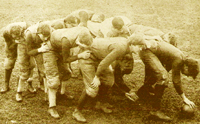

 Teenagers today play a central role in American culture and society. They exist not only as high school students, but as closely watched consumers and trendsetters. Yet in 1900, teenagers did not exist. There were young people in their teens, but there was no distinct teenage culture.
Teenagers today play a central role in American culture and society. They exist not only as high school students, but as closely watched consumers and trendsetters. Yet in 1900, teenagers did not exist. There were young people in their teens, but there was no distinct teenage culture.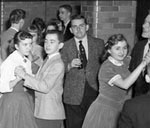

 2 hours. The manual advises, "After having mastered the form of the step, practise it at any convenient opportunity, though it is much better to have a specified hour each day. Two hours per day is little enough if the student is ambitious of excellence."
2 hours. The manual advises, "After having mastered the form of the step, practise it at any convenient opportunity, though it is much better to have a specified hour each day. Two hours per day is little enough if the student is ambitious of excellence." Open Position; Yale Position
Open Position; Yale Position 